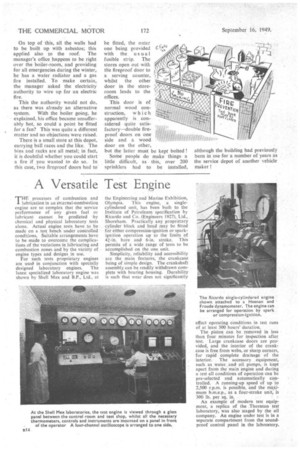A Versatile Test Engine T HEprocesses of combustion and lubrication in
Page 48

If you've noticed an error in this article please click here to report it so we can fix it.
an internal-combustion engine are so complex that the service performance of any given fuel or lubricant cannot, be predicted •by chemical and physical laboratory tests alone. Actual engine. tests_ have to be made on a test bench under controlled conditions. Suitable arrangements have to be made to overcome the complications of the variations in hibricating and combustion zones and by the variety of engine types and designs in use.
For such tests proprietary engines are used in conjunction with specially designed laboratory engines. The latest specialized laboratory engine was shown by Shell Mex and B.P., Ltd., at
the Engineering and Marine Exhibition, Olympia. This engine, a singlecylindered unit, has been built to the Institute of Petroleum specification by Ricardo and Co. (Engineers 1927), Ltd., Shoreham. PractiCally any proprietary cylinder block and head may be fitted for either compression-ignition or sparkignition operation up to the limits of 41-in, bore and 6-in. stroke. This permits of a wide range of tests to be accomplished on the one. unit.
Simplicity, reliability and accessibility are the main features, the crankcase being of Simple design, The crankshaft assembly can be readily withdrawn complete with bearing housing. Durability is such that wear does not significantly affect operating conditions in test runs of at least $00 hours' duration.
The piston can be removed in less than four minutes for inspection after. test. Large crankcase doors are pro vided, and the interior of the crankcase is free from webs, or sharp corners, for rapid complete drainage of the interior, The accessory equipment.; such as water. and oil pumps, is kept apart from The main engine and during a test all conditions of operation can be pre-selected and automatically controlled. A running-up speed of up to 2,500 r.p.m. is possible, and the maximum b.m.e.p., as a four-stroke unit, is 300 lb. per sq. in.
An example of modern test equipment, a replica of the ,Thornton test laboratory, was also staged by the oil company. An engine under test is in a separate compartment from the soundproof control panel in the laboratory.




















































































